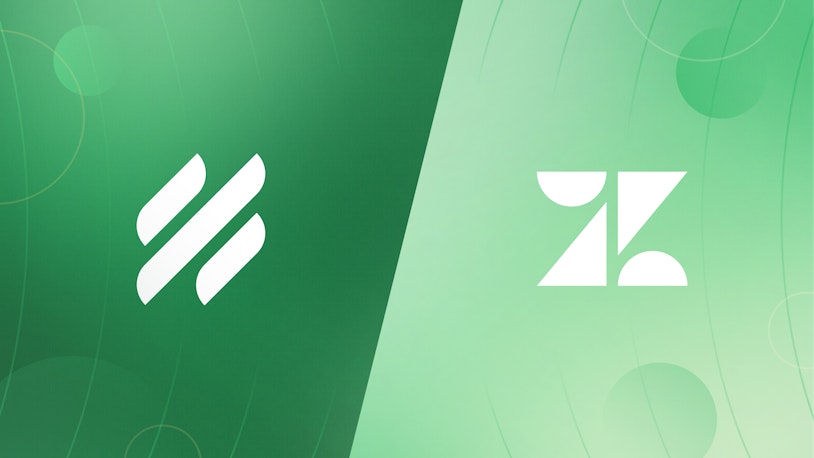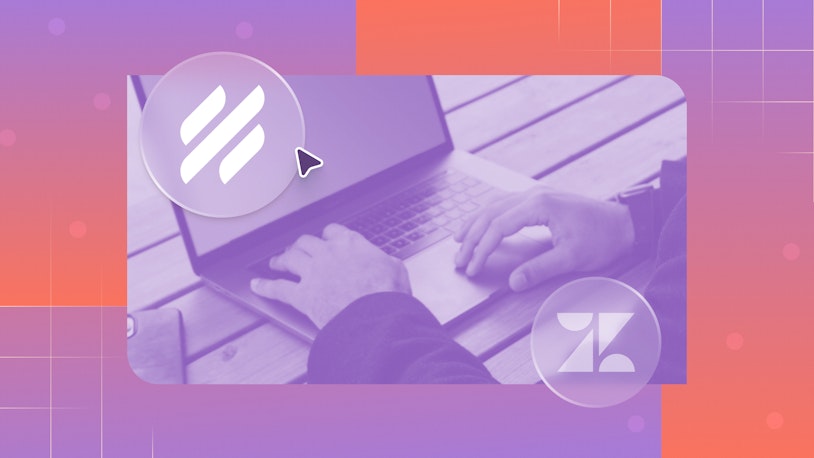If you're looking to replace Zendesk, this list of the best Zendesk alternatives (including free and paid options) will help you find the perfect fit. We dig deep into the options, sharing what types of teams and businesses they're best suited for, looking at how their features and pricing compare to Zendesk, reviewing what current customers have to say about them, and sharing the options each provides for migrating your data.
Top reasons companies switch from Zendesk to alternative platforms
There are a number of reasons why companies switch from Zendesk to other customer support platforms:
Taking advantage of many of the platform's features requires technical support from development or engineering teams.
The platform isn't very intuitive, making it difficult to train new agents to use it.
When you need support, you probably won't get it. Social media and review sites are full of complaints about Zendesk's service quality, particularly for their small and mid-sized customers.
It can take months to set up the platform. Zendesk's partners estimate that implementation takes a minimum of four weeks, plus an additional week for every 10 agents on your team.
Zendesk is one of the highest-priced customer support tools on the market. Its lowest-cost plan only includes email and basic social media support, and customers report having to consistently upgrade to higher-priced plans and pay for add-ons to get access to the basic features they need.
The 11 best overall Zendesk alternatives and competitors
If you're looking for a new customer support platform that has all of the features you need without the overhead, complexity, and opaque pricing, consider these 11 Zendesk alternatives:
Help Scout is the best Zendesk alternative for its affordability and ease of use, making it ideal for small to mid-sized businesses. Its user-friendly interface unifies customer conversations across email, chat, and social, and its thoughtfully built AI features make it easy to deliver delightful customer support quickly.
Intercom is the best choice for those who want to leverage advanced AI for customer support. Its AI-powered bots and automation features help businesses provide fast and personalized support to their customers.
Freshdesk stands out for its vast number of integrations, with almost 700 apps in its marketplace. This makes it a great option for businesses that need to connect their customer service software with a wide range of other tools.
Zoho Desk is an affordable alternative to Zendesk for companies that need community forums. It allows customers to help each other and provides a platform for support agents to engage with the community.
Kustomer is a great choice for large ecommerce companies that want a complete view of their customers. It integrates with popular platforms like Shopify and BigCommerce to provide a comprehensive timeline of the customer's journey.
Gorgias is the best Zendesk alternative for small ecommerce companies, especially those using Shopify. It helps online stores provide excellent customer service by centralizing all their support channels in one place.
HubSpot Service Hub is the ideal Zendesk alternative for customer success teams, especially in sales-led companies. It works alongside HubSpot's CRM and marketing tools, allowing for better collaboration between departments.
Salesforce Service Cloud is the best option for large enterprises with high support volumes and complex needs. It offers extensive customization and powerful reporting tools, and it integrates natively with Salesforce CRM.
Microsoft Dynamics 365 Customer Service is best for large companies that are heavily invested in the Microsoft ecosystem. It features AI powered by Microsoft's Copilot and integrates with Microsoft Teams for easy collaboration.
Jira Service Management is the perfect fit for IT and DevOps teams that need a robust service desk solution. It's built on ITIL best practices and integrates with other Jira products for efficient issue tracking and project management.
Dixa is a great one-to-one replacement for Zendesk for those who are not looking to cut costs. It offers intelligent routing for directing support inquiries to the right agents and provides native omnichannel support.
If you're looking for free options, keep scrolling. We'll cover those later in the article.
1. Help Scout – Best Zendesk alternative for affordability and ease of use
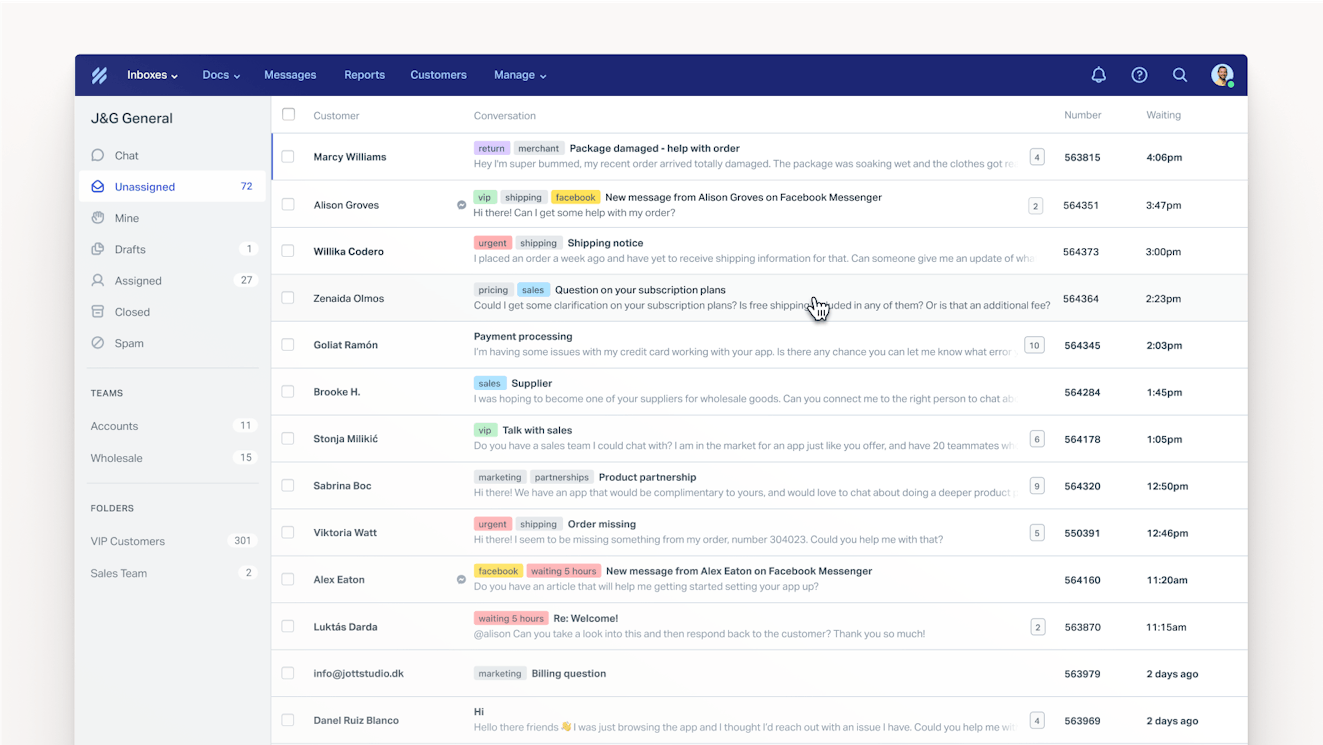
Help Scout's customer service platform has all of the power of Zendesk without the complexity. Its intuitive, user-friendly interface means the learning curve for using Help Scout is minimal: You’ll be up and running in a matter of hours and an expert user by the end of week one. It's also more affordable than Zendesk and offers a very generous free plan for small businesses.
Who is Help Scout a good fit for?
Help Scout is great for small to mid-sized SaaS and ecommerce businesses that are looking for a platform that's easy to use and affordable. You get access to all of its support channels on all of its plans, it offers industry-specific must-haves like Shopify and HubSpot integrations, and the customer support you'll receive when you need help is second-to-none.
Key features
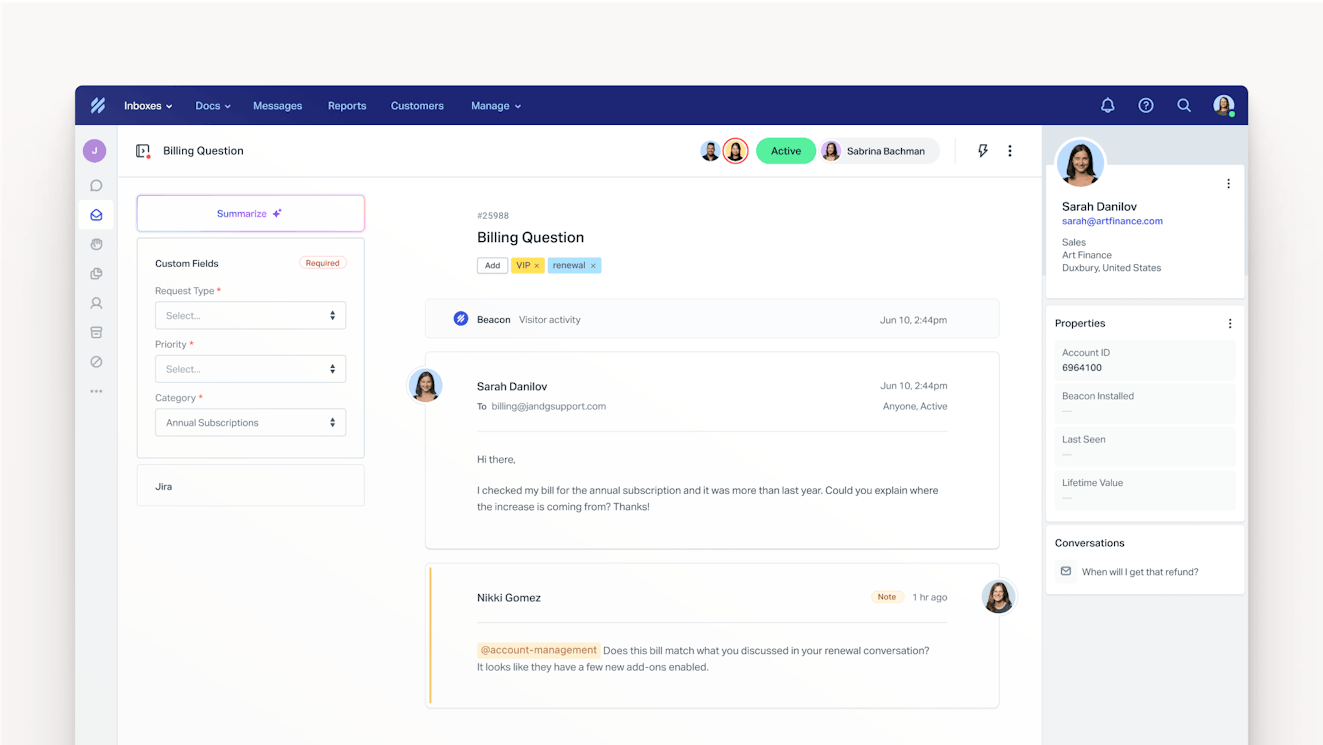
When you sign up for Help Scout, you get access to a feature-rich platform with a variety of powerful customer support tools:
Multi-channel support: Create one or more team inboxes to manage your customer conversations across multiple channels — email, chat, and social media.
Collaboration: Collaborate more effectively with private notes that let your team exchange information about conversations before replying to customers and real-time collision detection that prevents multiple team members from working on or replying to the same request.
Automation: Save time with saved replies that make answering routine customer requests a breeze, or set up workflows to automate things like assigning conversations to specific teams or agents.
Customer data: View customer profiles alongside conversations to get the context you need to deliver personalized customer support.
Self-service options: Create a help center that makes it easy for customers to find the information they need when they need it.
AI: Use AI to automatically reply to customer queries, write draft replies that you can review before sending, summarize long conversation threads, translate replies into different languages, clean up spelling and grammar issues, and make length or tone changes.
Customer communications: Reach out to customers proactively with in-app messaging. Launch a chat window or surface a help doc during tricky places in the customer journey, place a banner on your site to announce a new feature, or even send out a survey to capture customer feedback.
Reports and analytics: View reports to see things like what times of day are busiest, common reasons for customer queries, CSAT results, and which communication channels are most popular with your customers. Or create custom views to focus on the metrics you care about most.
Responsive customer support: Help Scout has one of the highest ratings for customer support of all of the help desks on the market. As one customer says: "The customer support is over-the-top, amazing, above-and-beyond helpful."
Migrating from Zendesk to Help Scout
Help Scout offers automatic migration from Zendesk to Help Scout using Import2, and the service is completely free for most customers.
Import2 will migrate all of your support tickets/emails, tags, and customer profiles from Zendesk to Help Scout, and Help Scout also has a separate tool you can use to migrate your help center articles.
Reviews from customers who switched from Zendesk to Help Scout
"Having worked with Zendesk before, the difference was night and day. Our team enjoys Help Scout because of the ease of use, user-friendly platform, reporting, and more! Support is always quick to respond and helpful when we need guidance." Read the full review.
"We don't need a major solution like Zendesk, and Help Scout is the happy medium of exactly the features we need for our support efforts. I am able to quickly train new team members on how to use Help Scout, and that helps us scale quickly while spending smartly!" Read the full review.
Pricing
Free plan and trial available. View Help Scout's current pricing.
Learn more about Help Scout:
2. Intercom – Best Zendesk alternative for advanced AI support
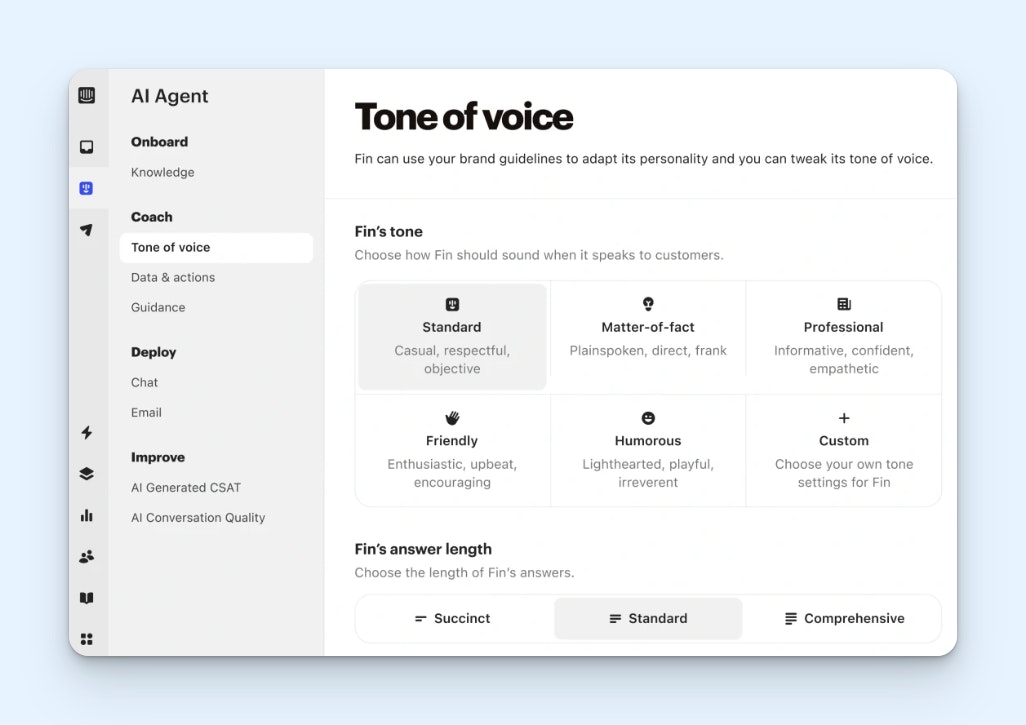
Intercom is the market leader when it comes to AI customer service software. The platform is full of AI features that answer customers' questions automatically, help agents write replies, update data in integrated systems, provide CSAT ratings on all support interactions, and more.
Its AI chatbot, Fin, answers customers' questions automatically and can be used on email, chat, social, and SMS by default. You can also purchase add-ons to use it to answer questions received over the phone, on Slack, or through other systems you've connected using Intercom's API. It's trained on content from your website, knowledge base, and support tickets.
Intercom's AI copilot helps your team draft replies quickly. It pulls knowledge from your help center and previous conversations your team has had with customers to compose replies in seconds, and it also shows you the sources it used so you can fact-check if necessary.
Other AI features you'll find in the Intercom will do things like update data in third-party systems when necessary to help customers, predict and add CSAT scores to all conversations even when customers didn't complete a survey themselves, and provide insights that show instances where the support a customer received didn't meet expectations.
Keep in mind that all of this automation comes at a cost. Fin is priced per-resolution, and most of the other AI features we mentioned are sold as add-on products on top of the platform's base per-user help desk fees. With that in mind, it's not an option that will reduce your support software bill, but it may be worth it if you're looking to automate everything.
Who is Intercom a good fit for?
Intercom is a great customer service platform for any business that's looking for advanced automation capabilities. While its price will increase with every new AI feature you add, there's no shortage of ways you can automate your support operations using Intercom.
Key features
Fin: Automatically answers questions over email, chat, social, and SMS.
AI copilot: Writes draft replies for agents.
Fin Tasks: Updates data in third-party systems to resolve customer requests.
CX Score: Adds CSAT ratings to 100% of support tickets.
AI Insights: Alerts you to instances of customers receiving poor-quality support.
Fin Voice: Automatically answers questions received over the phone.
Fin over Slack: Answers questions received over Slack.
Fin over API: Connect other systems to use Fin anywhere you need it.
Migrating from Zendesk to Intercom
Intercom has built-in tools to help you migrate your users, knowledge base articles, and conversation history (with a caveat) from Zendesk.
To migrate users, you download a CSV from Zendesk and upload it to Intercom. To migrate your help center, you simply enter its URL into Intercom, and Intercom imports the articles.
It's important to note that importing your Zendesk conversation history (support tickets) does not give you access to those conversations in Intercom. Instead, it just uses that data to train Fin.
Reviews from customers who switched from Zendesk to Intercom
"While using Zendesk, we were at an average CSAT score of 64%, and after just three months with Intercom, we've been reporting between 85% to 100% CSAT. This is a major improvement that we know couldn't have been possible without Intercom." Read the full review.
"My favorite thing about Intercom is how user-friendly the entire platform is. We've used Zendesk in the past, and when it came to onboarding a new employee, Zendesk always was our biggest learning curve. Intercom eliminates a lot of the hassle because things are just super easy to use!" Read the full review.
Pricing
Free trial available. View Intercom's current pricing.
3. Freshdesk Omni – Best Zendesk alternative for variety of integrations

One of the big advantages of Zendesk is that it integrates with nearly 2,000 other tools. The only other customer service platform on the market that comes close is Freshdesk, which offers nearly 700 integrations through its app marketplace. If integrating your customer support software with other niche tools your company uses is a must-have, Freshdesk is likely the right choice for your team.
Freshdesk Omni is the platform's omnichannel option. It allows teams to deliver support over email, chat, and social, and you can also build customer portals and community forums. Native phone support capabilities are available through its Freshcaller add-on, and you can even use Freshdesk's AI voicebot, Freddy AI, to automatically answer customer questions over the phone.
Beyond these features, you'll get access to the same channels and tools you'll find in any help desk: a shared inbox, knowledge base, workflow automation, round-robin ticket routing, and mobile apps. You can use AI to automatically reply to customers' questions via email and messaging apps, and you can even build vertical-specific AI chatbots to handle questions from customers in specific industries.
Who is Freshdesk a good fit for?
Freshdesk is ideal for teams looking for a lower-cost option that need access to a robust library of integrations. It's second behind Zendesk in terms of the number of integrations it offers, it has decent feature parity with Zendesk, and its pricing is lower than Zendesk's, particularly when it comes to using the platform's AI features.
Key features
Pre-built integrations with nearly 700 software providers.
AI agent that answers customer inquiries on phone calls.
Automated and round-robin ticket routing.
Sentiment analysis tool that prioritizes customer inquiries.
AI writer that creates full knowledge base articles based on a prompt.
Migrating from Zendesk to Freshdesk
Freshdesk does not offer any native migration tools for importing your Zendesk data into its system. However, it does integrate with the third-party service Help Desk Migration, which can do the data transfer for you for a fee.
Reviews from customers who switched from Zendesk to Freshdesk
"It's easy to use and in some ways more intuitive than Zendesk. The support we receive is great, and the Freshdesk team is always available via chat. The platform is pretty quick and looks nicer than Zendesk to me personally." Read the full review.
"Several integrations. Allows me to provide customer service for different products and companies. Easy setup and integrations. Lets me create different signatures, canned responses, etc. I've used Zendesk as well and can confidently say that Freshdesk is more robust and far easier to use!" Read the full review.
Pricing
Free plan and trial available. View Freshdesk's current pricing.
4. Zoho Desk – Best Zendesk alternative for community forums
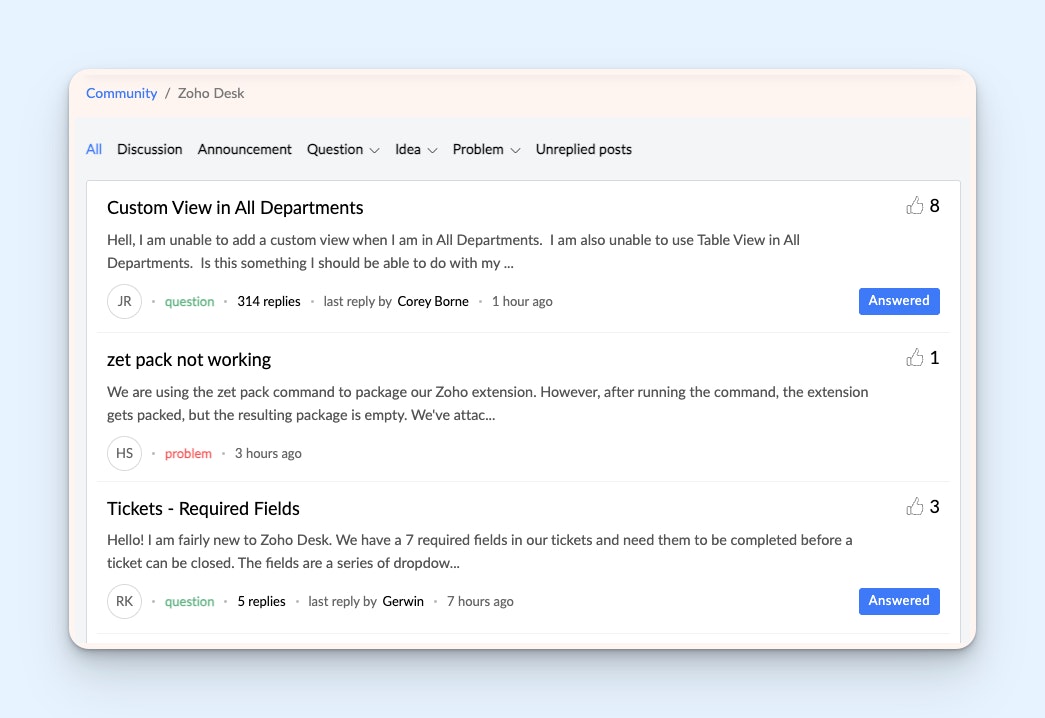
Another Zendesk feature you won't find in all help desks is its community forums. Freshdesk has them, but only on its higher-tier plans ($69/agent per month). Zoho Desk offers forums at a much lower cost, starting at $14/agent per month.
With Zoho's community forums, your customers can ask their own questions and answer those asked by other customers. Community members can upvote conversations to show support for things like feature requests. Agents can answer questions and bump their replies to the top. And everything can be indexed by search engines to provide another way for customers to find the answers they're looking for quickly.
Zoho also offers its own entire ecosystem of business apps, so it can be a good choice if you're looking to replace several of the tools in your tech stack. It has a customer relationship management tool, business intelligence tool, project management platform, and HR software — just to name a few.
Who is Zoho Desk a good fit for?
Zoho Desk is great for teams looking for an affordable customer service platform that lets them deliver customer support across all channels and create community forums. You'll likely see a significant price reduction when switching from Zendesk to Zoho Desk without losing much of the functionality you had available to you in Zendesk.
Key features
Integrations with Telegram, WeChat, Line, Messenger, and WhatsApp.
SLAs with automatic escalations for overdue support tickets.
Branded community forums for customers to ask and answer questions.
Guided conversations to take customers through automated, step-by-step flows.
AI ticket summaries and reply assistance via ChatGPT integration.
Complete ecosystem of business apps under the Zoho umbrella.
Migrating from Zendesk to Zoho Desk
Zoho Desk has its own platform, Zwitch, that can be used to migrate your data from Zendesk. It will transfer your agents, tickets, conversations, threads, customers, contacts, and knowledge base articles. Unfortunately, if you have an existing community forum on Zendesk, that data cannot be migrated to Zoho Desk using Zight.
Reviews from customers who switched from Zendesk to Zoho Desk
"One of the standout positives is the responsive customer service — they reply relatively quickly, addressing issues more efficiently than what we experienced with Zendesk. Additionally, the user interface feels significantly better. It's intuitive and streamlined, making it easier for our team to manage tickets and navigate the platform." Read the full review.
"The guide to migrate data from Zendesk to Zoho Desk is user-friendly and quick to follow. Fast response to queries from customer support. Easy to navigate platform." Read the full review.
Pricing
Free plan and trial available. View Zoho Desk's current pricing.
5. Kustomer – Best Zendesk alternative for large ecommerce companies

Kustomer stands out due to its variety of integrations with the tools that ecommerce customer support teams use. It integrates with systems like Shopify, BigCommerce, LoyaltyLion, Adobe Commerce (Magento), Recharge, and more to make it easy for you to access the customer and transaction data you need to deliver quick and personalized support.
Its Shopify integration, as an example, can be set up in one click. Once activated, it shows all of your Shopify data in a sidebar: transactions, tracking numbers, order numbers, and shipping addresses. Additionally, you can do things like process refunds and cancel orders without leaving the Kustomer interface.
The data from your integrated systems is also used to power Kustomer's AI chatbot, enabling the bot to do more sophisticated things like process refunds, update orders, and provide details on when shipped products will arrive. It also answers more general questions for customers using information from your knowledge base.
Who is Kustomer a good fit for?
Kustomer is an ideal customer service solution for large ecommerce and retail businesses. In addition to integrating with all of the popular ecommerce platforms, it has AI that can automatically reply to requests over chat, email, phone, and SMS. It also has integrations with Facebook, WhatsApp, X, and Instagram — key channels for ecommerce customer support teams.
Key features
AI agent that writes replies based on existing knowledge base articles.
Voice AI that can answer customer questions on phone calls.
Ecommerce integrations with Shopify, BigCommerce, Adobe Commerce, and more.
Customer profiles with order histories, preferences, and previous support inquiries.
Create multiple AI agents to handle different types of requests.
Migrating from Zendesk to Kustomer
Kustomer has its own custom-built tool that customers can use to transfer tickets, tags, users, and groups from Zendesk to Kustomer automatically.
Reviews from customers who switched from Zendesk to Kustomer
"It's the best full-boat CSM/CRM I've used. We migrated from Zendesk because their sales and support were terrible to us. The Kustomer team is responsive, helpful, and was there through the entire implementation and beyond. I couldn't be happier with Kustomer as a product and company." Read the full review.
"Kustomer has a great layout and is very user-friendly. I would say it has less of a learning curve than Zendesk. I have trained people how to use it in as little as a day or two. It is easy to find where to do certain functions, and the icons make sense!" Read the full review.
Pricing
No free trial offered. View Kustomer's current pricing.
6. Gorgias – Best Zendesk alternative for small ecommerce companies

If you're looking for a help desk for a small ecommerce shop, another option to consider is Gorgias. Like Kustomer, Gorgias is built specifically for ecommerce, offering deep integrations with platforms like Shopify, BigCommerce, Magento, WooCommerce, and PrestaShop. However, its Shopify integration is really the highlight of the platform.
Gorgias integrates deeply with Shopify, allowing you to not only see customer orders inside of Gorgias but also refund, duplicate, cancel, or edit orders without leaving Gorgias. You can also search for items in your product catalog to insert into support requests as links and see how much available inventory you have for a product.
Gorgias' AI features also use data from Shopify to automatically answer routine support requests. If a customer writes in asking for an update on their order, the AI can access the order details in Shopify and respond to the customer with the information they need without any of the humans on your customer support team needing to get involved.
Who is Gorgias a good fit for?
Gorgias is a great option for small ecommerce startups that use Shopify. It's pricing is significantly lower than some of the other ecommerce-focused platforms on the market like Kustomer and Gladly, and its Shopify integration is one of the most robust options available.
Key features
Integrations with Shopify, BigCommerce, Magento, WooCommerce, and PrestaShop.
Deep Shopify integration that lets you refund, edit, and cancel orders within Gorgias.
Product catalog is searchable inside of Gorgias and lets you see available inventory.
Reply to social media messages from Facebook, Instagram, and WhatsApp.
Create marketing campaigns in Gorgias to increase sales and revenue.
Use AI to answer FAQs and inquiries about orders automatically.
Migrating from Zendesk to Gorgias
Gorgias has a built-in import tool that migrates your macros, users, tags, and tickets from Zendesk into Gorgias. The tool will import all tickets from the last two years and process about 720 tickets per hour, so if you have a lot of tickets, it can take several days to complete.
Reviews from customers who switched from Zendesk to Gorgias
"Moving over to Gorgias from Zendesk was an interesting transition. From the very beginning, we had a support team that helped us make that transition. The help docs were essential and kept up to date." Read the full review.
"We used to work with Zendesk, and when we found Gorgias, we realized how much easier it is to have all the customer's information right where their email comes in so you don't have to go searching in four different platforms before you can answer." Read the full review.
Pricing
Free trial available. View Gorgias' current pricing.
7. HubSpot Service Hub – Best Zendesk alternative for customer success

HubSpot Service Hub stands out with its features for customer success teams. Its connection with HubSpot's customer relationship management and marketing products makes it easy to collaborate with sales and product marketing on cross-sell, upsell, and renewal campaigns. You'll be able to see all interactions sales and marketing have had with your customers alongside details like renewal dates and contracts in each customer's profile.
HubSpot's also has a customer success workspace that shows you your entire book of business in a single view. You can set up customer health scores that factor in specific interactions you specify. For example, positive customer feedback might add points, where requesting customer support might deduct points. The health scores are color-coded and provide you with an easy way to identify issues and prevent churn.
HubSpot also lets you create individual portals for specific customers, set SLAs for response times, and send pre-built Net Promoter Score, customer effort score, and customer satisfaction surveys.
Who is HubSpot Service Hub a good fit for?
HubSpot Service Hub is a great option for sales-led companies that delegate the responsibility of delivering customer support to their customer success and account management teams. Few other support platforms offer features that not only help you manage and reply to customer inquiries but also measure the health and churn risk of customers, making it ideal for teams focused on both customer support and retention.
Key features
Customer support platform that's fully integrated with HubSpot CRM and Marketing Hub.
Build secure portals for individual customers.
Customer success workspace with health scores and insights to reduce churn.
SLAs that can be customized for working hours.
AI agent that's trained on your knowledge base articles and blog posts.
Migrating from Zendesk to HubSpot Service Hub
HubSpot does not offer any native migration tools for importing your Zendesk data into its system. However, it does integrate with the third-party service Help Desk Migration, which can do the data transfer for you for a fee.
Reviews from customers who switched from Zendesk to HubSpot Service Hub
"Switched to HubSpot from Zendesk and never looked back! As a user, HubSpot is simple to use and easy to implement and customize. It has simplified our sales/renewals process, and the knowledge base has been a game changer!" Read the full review.
"Compared to Zendesk, the interface is much more intuitive (which HubSpot is known for), and the customizable workflows are massive time savers. Only took a couple of weeks to set up, automate, and train my entire development team since we were already using HubSpot's CRM." Read the full review.
Pricing
Free plan and trial available. View HubSpot's current pricing.
8. Agentforce Service – Best Zendesk alternative for large companies
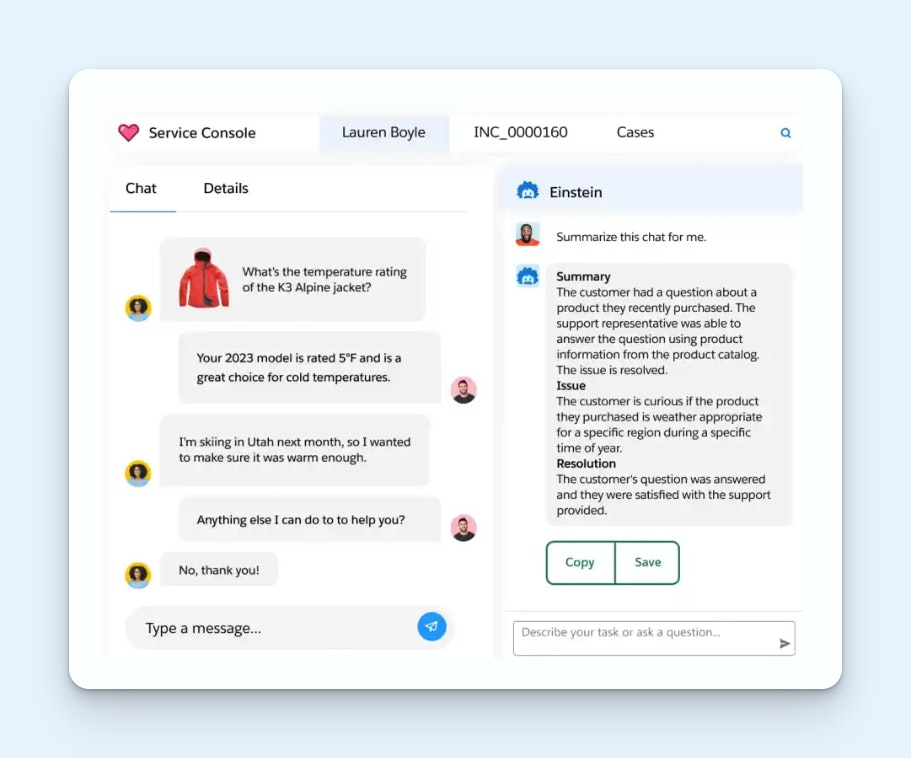
If you found Zendesk's complexity to be a feature rather than a hurdle, Agentforce Service (formerly Salesforce Service Cloud) is probably the best alternative for you. It's built for large companies that have highly complex processes and organizational structures, with features like incident detection, diagnostic tools, broadcast communications, asset tracking, and omnichannel routing.
Agentforce Service is also a good option for companies that offer on-site product support. Its field service management features include dispatch and scheduling tools, work order management, and a mobile app to help your technicians in the field, even when Wi-Fi access isn’t available.
Finally, Agentforce offers a variety of AI tools to expedite customer service operations. You can use its chatbot to automatically reply to customer questions and requests. It can even understand and reply to pictures, videos, and audio files that customers send. You can also turn support conversations into knowledge base articles automatically.
Agentforce's AI tools also use its Einstein Trust Layer to make sure the AI never shares private data, and you can set up specific rules for the types of queries that should always be routed to a human support agent.
Who is Agentforce Service a good fit for?
Agentforce Service is a good fit for large companies, particularly if you're already using Salesforce for customer relationship management. While it's one of the most expensive options on the market, the cost gets you access to an incredibly robust suite of tools that includes everything from omnichannel support to field service management and asset tracking.
Key features
Field service management for dispatching and scheduling agents.
Turn customer support replies and conversations into knowledge base articles using AI.
Einstein Trust Layer to prevent AI from sharing protected information.
Incident detection, diagnostics, and broadcast communications.
Native integration with Salesforce CRM.
Create a swarm channel in Slack directly within Agentforce to resolve complex issues.
Migrating from Zendesk to Salesforce Service Cloud
Salesforce does not offer any native migration tools for importing your Zendesk data into Agentforce Service. However, it does integrate with the third-party service Help Desk Migration, which can do the data transfer for you for a fee.
Reviews from customers who switched from Zendesk to Salesforce Service Cloud
"We migrated from Zendesk to Service Cloud and got a lot of value out of the platform. It was great in improving our user workflows and centralizing a full view of the customer in Salesforce." Read the full review.
"Our biggest problem has been a lack of comprehensive data coming from Zendesk, but now we have so much data and a lot of dashboards that provide vital information that is required to implement process improvements." Read the full review.
Pricing
Free trial available. View Agentforce Service's current pricing.
9. Microsoft Dynamics 365 Customer Service – Best for enterprise companies

Microsoft Dynamics 365 Customer Service is a great alternative to Zendesk and Agentforce Service for enterprise companies that already heavily use applications in the Microsoft ecosystem. Its built-in AI is powered by Microsoft's Copilot — an industry-leading AI tool — and its native integration with Microsoft Teams makes it easy to collaborate on tickets in your chat app.
Copilot connects to your knowledge base to answer customers' questions automatically. It can also route customers with more complex inquiries to a support agent, using AI to determine the best person to reply to the ticket based on their expertise, skillset, and workload. When routing a ticket, the AI summarizes the request so agents can get up to speed quickly.
If text-based questions and answers aren't working for resolving an issue, agents can quickly create a link to invite the customer onto a Teams video chat. They can also start a chat in Teams with other agents who handled similar queries in the past to get help solving problems they don't know how to solve.
When an agent arrives to work for the day, Copilot provides them with a summary of all of the cases that have been assigned to them. Finally, Copilot is also built into the system's reporting features, providing managers with AI-driven insights on topics to address and metrics to look into more deeply.
Who is Microsoft Dynamics 365 Customer Service a good fit for?
Microsoft Dynamics 365 Customer Service is a great ticketing system for enterprise-level companies because of its strong security features and ability to integrate with other enterprise-focused tools like SAP and Oracle. It's also ideal for companies that are already using other tools in the Microsoft ecosystem because of its ability to seamlessly integrate with other Microsoft platforms.
Key features
AI features powered by Microsoft Copilot.
Integration with Microsoft Teams to video chat with customers.
AI-powered skill- and capacity-based routing.
Create custom community forums and customer portals.
Connect with other Microsoft products easily.
Automatically translate requests and responses into other languages.
Migrating from Zendesk to Microsoft Dynamics 365
Microsoft does not offer any native migration tools for importing your Zendesk data into its system. However, it does integrate with the third-party service Help Desk Migration, which can do the data transfer for you for a fee.
Pricing
No free trial offered. View pricing for Microsoft Dynamics 365 Customer Service.
10. Jira Service Management – Best Zendesk alternative for IT support teams
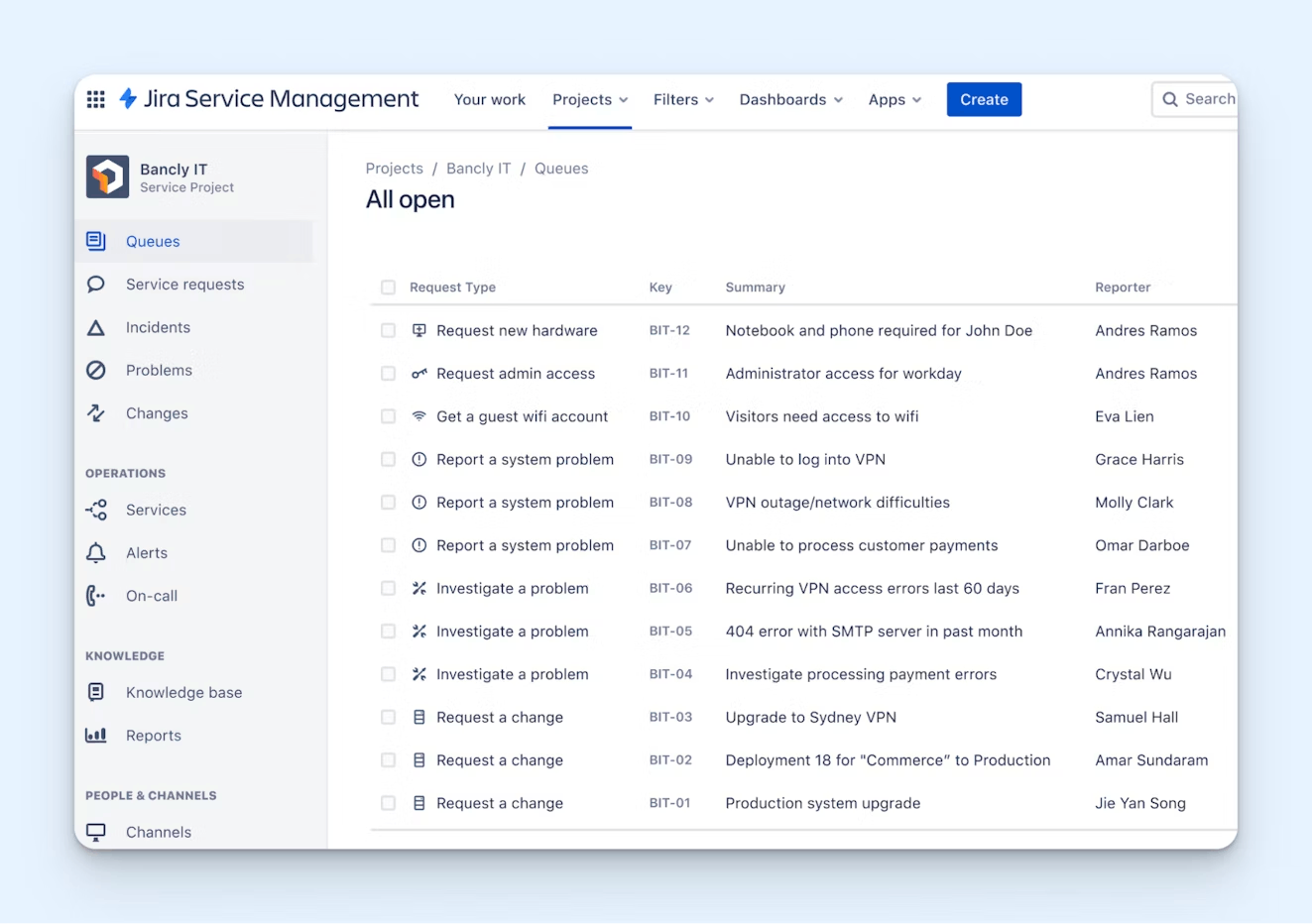
While Zendesk can be used by more technical DevOps or IT support teams, it's not really built for that use case — it's primarily designed for customer service teams. For an alternative that is designed for technical support, Jira Service Management's robust ticketing system is probably your best bet.
For IT support teams, you can create a service desk, use AI to provide automated answers, configure SLAs, and manage your company assets. You can also code your own intake forms and automated workflows or access libraries of hundreds of pre-built, no-code templates.
For DevOps teams, you can link tickets to issues reported in Jira — Atlassian's bug-tracking tool — as well as manage incidents, aggregate product requests, and group similar incidents and bugs together as problems. You can also use its API to integrate with any programming or email tools you use.
IT operations teams can coordinate efforts across multiple teams to manage change requests, prevent incidents, monitor new releases, and create on-call schedules.
Who is Jira Service Management a good fit for?
Jira Service Management is a great fit for IT and DevOps teams. Unlike the other platforms on this list, it's much more geared to those use cases than it is to external customer support with features for incident, problem, asset, and change management.
Key features
Built-in system setup templates for ITSM, customer support, and HR use cases.
Track IT assets for inventory management, auditing, and lifecycle analysis.
AI agent that's trained on your knowledge base articles.
AI-powered ticket summaries, prioritization, and routing.
REST API and open platform for building custom add-ons.
Change requests with risk assessments, approvals, and deployment tracking.
Migrating from Zendesk to Jira Service Management
Atlassian does not offer any native migration tools for importing your Zendesk data into Jira Service Management. However, it does integrate with the third-party service Help Desk Migration, which can do the data transfer for you for a fee.
Reviews from customers who switched from Zendesk to Jira Service Management
"We are moving from Zendesk which is $99 per month per user to Jira which is looking to be about a $30 per month flat rate for us, saving us (a small company) a huge amount." Read the full review.
"Great replacement for Zendesk. Nice clean interface for users and the help desk team. Takes a little longer to configure than expected, but once set up, it's great." Read the full review.
Pricing
Free plan and trial available. View Jira Service Management's current pricing.
11. Dixa – Best Zendesk alternative for multi-department collaboration

For larger companies with more complex organizational structures, Dixa is a good choice. It comes with several unique features that make cross-team collaboration easy.
Its side conversations expand on the private notes feature of other help desks by allowing you to not only tag internal colleagues but also send an email to individuals who aren't Dixa users in your organization (e.g., vendors, partners, or other third parties). The conversation and all replies can be created and viewed alongside the customer's original ticket.
Dixa also has sophisticated automatic routing rules. Instead of putting all of your requests into a single shared inbox for your team to cherry-pick, it automatically assigns new tickets to the person who's best equipped to respond to the request. It does this by evaluating priority, skill sets, and availability.
Finally, Dixa offers a drag-and-drop, no-code builder that lets you create your ideal workflows without any IT support. You can specify what types of requests are automatically routed, create smart rules to specify what's answered by AI and what goes into the queue, and even automatically close spam or irrelevant requests.
Who is Dixa a good fit for?
Dixa is a good option for mid-size and large companies where delivering customer support is a cross-team effort. It lets you collaborate easily not only with other teams inside of your company but also with external vendors, suppliers, and other third-parties, making it ideal for teams that need lots of collaboration to reply to customers.
Key features
AI agent that's trained on your knowledge base articles.
Prioritize customer inquiries by VIP status, lifetime value, or churn risk.
No-code builder for workflow automation.
Routing rules based on priority, skill sets, and availability.
Native omnichannel support for email, phone, chat, and social media.
Conversation timelines show a visual representation of conversation histories.
Migrating from Zendesk to Dixa
Dixa does not offer any native migration tools for importing your Zendesk data into its platform. However, it does integrate with the third-party service Help Desk Migration, which can do the data transfer for you for a fee.
Reviews from customers who switched from Zendesk to Dixa
"I love how easy it is to customize the dashboards (especially compared to Zendesk Explore). The team at Dixa is constantly pushing improvements, and they're highly receptive to ideas for product developments." Read the full review.
"The step away from Zendesk is much easier than expected. We had a feeling that we were very tied to Zendesk, but in reality, it was a very fast and smooth transition." Read the full review.
Pricing
No free trial offered. View Dixa's current pricing.
The 8 best free Zendesk alternatives
If you're looking to migrate to a new platform because you can no longer afford to pay a monthly fee for support software (or are looking for ways to cut costs), the eight free Zendesk alternatives below are all good options. While some of the tools here were also recommended in the section above, we're including them again so we can highlight what you get in each tool's free plan.
1. Help Scout – Best for small businesses

Help Scout is a great choice for small businesses that are planning to grow. On its free plan, up to five people on your team can manage email requests in a shared inbox, and you can also create a help center to enable your customers to find answers to their questions on their own.
Free plan features
Up to five users: As many as five people on your team can reply to email requests and create knowledge base articles on Help Scout's free plan.
One shared inbox: You get one shared inbox that will contain all of the emails sent to your support email address.
One Docs site: Build an external knowledge base that makes it easy for customers to find answers to their questions and troubleshoot problems on their own.
Productivity tools: Create saved replies to answer FAQs in just a couple of clicks, and use keyboard shortcuts to perform common actions quickly.
Collaboration tools: Prominent collision detection alerts prevent multiple users from working on the same conversation at the same time. You can also leave private notes on customer conversations to collaborate as a team on replies.
Organization tools: Add tags to label and sort conversations, and snooze conversations you want to temporarily hide from your inbox view.
What’s included?
Help Scout’s free plan includes up to five users, one shared inbox, one help center with up to 10 articles, 10 tags, 10 saved replies, and reporting for 30 days of data.
2. Hiver – Best for all-hands support
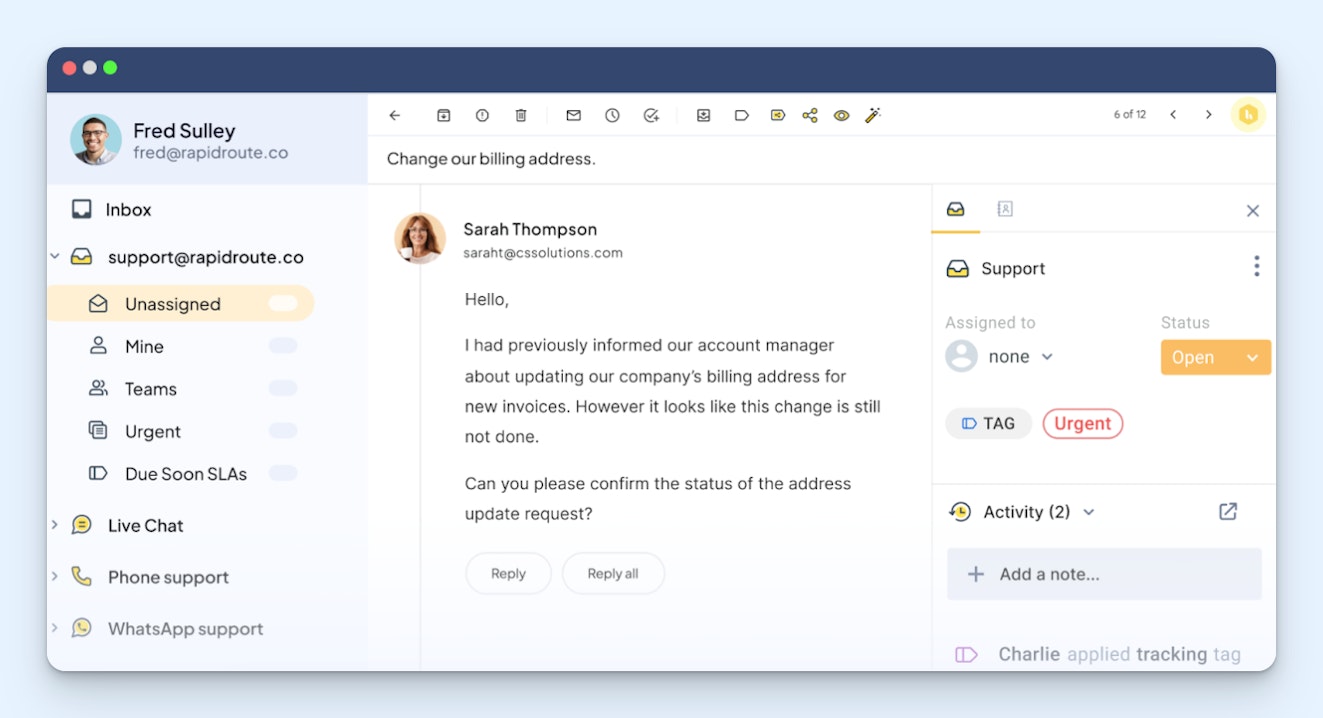
Small businesses that manage support requests by having everyone in the company spend some time in the queue will like Hiver. In addition to letting you answer customers' questions over email, chat, WhatsApp, and phone, its free plan lets you add unlimited users at no cost.
Free plan features
Unlimited users: Add everyone at your company to your Hiver shared inbox with no additional costs.
Omnichannel support: Hiver’s free plan includes channels for email, live chat, WhatsApp, and phone support, and you can also create a knowledge base.
Collaboration tools: Share draft replies with other team members to collaborate on them before sending, and add collaborators or create permalinks to share requests and replies with people who don’t have Hiver accounts.
Organization tools: Create shared and personal views to organize requests into lists that show only the inquiries you need to see.
What’s included?
Hiver’s free plan includes unlimited users and tickets, one shared email inbox, one tag, one email template, and its Slack integration.
3. HubSpot Service Hub – Best for customer success

HubSpot Service Hub is a good option for small customer success teams that need to collaborate with sales teams that work in HubSpot CRM. While its free plan features are pretty limited, it offers enough of the basics — like email and live chat support — to let you easily manage customer requests while you’re in the early stages of building out your department.
Free plan features
Two users: You can add up to two users on HubSpot’s free plan.
Email, chat, and social support: Create a shared team inbox, publish a live chat widget with HubSpot branding, and integrate with Facebook Messenger.
Knowledge base: Publish a knowledge base that contains up to five articles.
Productivity features: Create up to three canned snippets and three email templates, and get a limited version of HubSpot’s chatbot for routing customers to the right team member or knowledge base article.
What’s included?
HubSpot Service Hub’s free plan includes two users, unlimited tickets, a shared inbox, a live chat widget, its Facebook Messenger integration, five knowledge base articles, three canned snippets, three email templates, and a limited version of its chatbot.
4. Zoho Desk – Best for SLAs
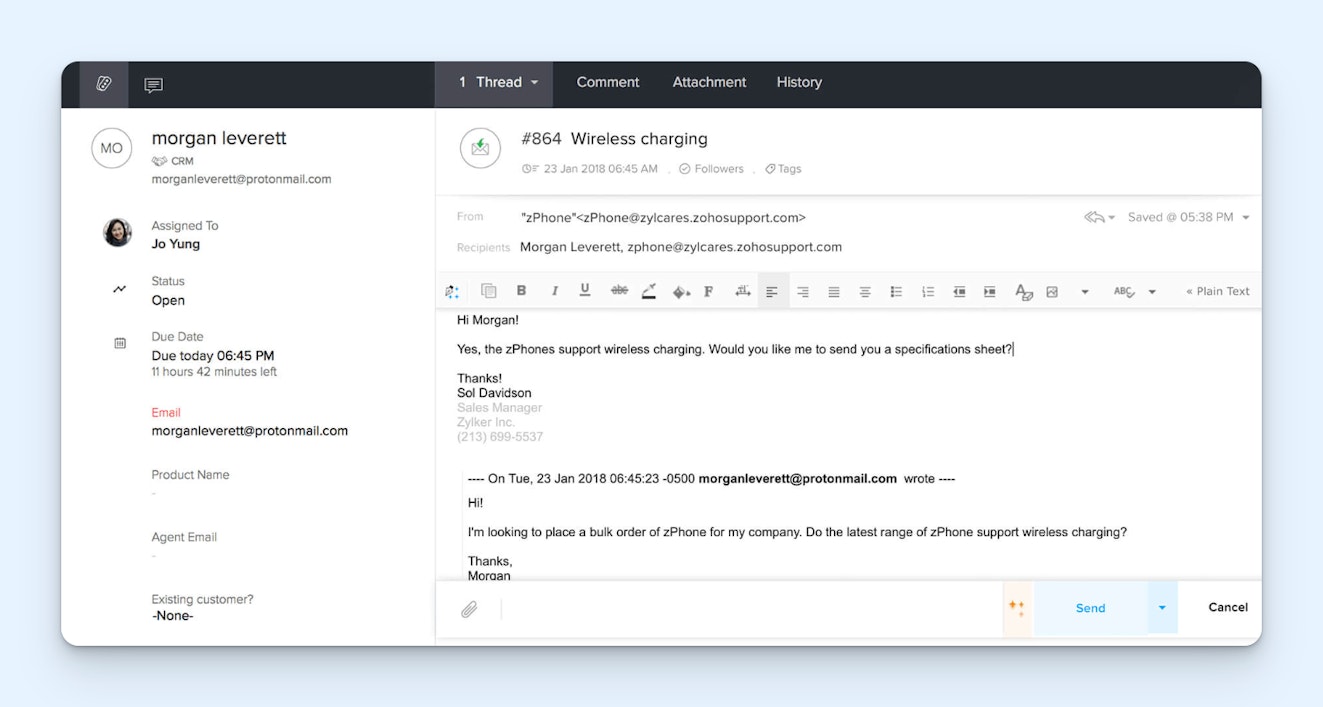
Zoho Desk is a good free alternative to Zendesk for small teams that need service-level agreements and only offer email support. While only one SLA is included on the free plan, that may be enough for a team of no more than three people (the limit on Zoho Desk’s free plan).
Free plan features
Three users: You can add up to three users on Zoho Desk’s free plan.
Email and self-service support: Create one shared inbox and one help center. Get versioning on your help center articles to see changes made to articles over time. Leave internal notes on email tickets to collaborate with your team privately.
Service-level agreement: Create one SLA on the free plan. You also have the ability to pause the SLA counter on tickets that are blocked.
What’s included?
Zoho Desk’s free plan can be used by up to three agents to answer unlimited inquiries and includes one email inbox, private notes, up to 10 tags per ticket, one help center, one contact form, two macros, one SLA, and knowledge base article versioning.
5. ProProfs Help Desk – Best for single-person support teams
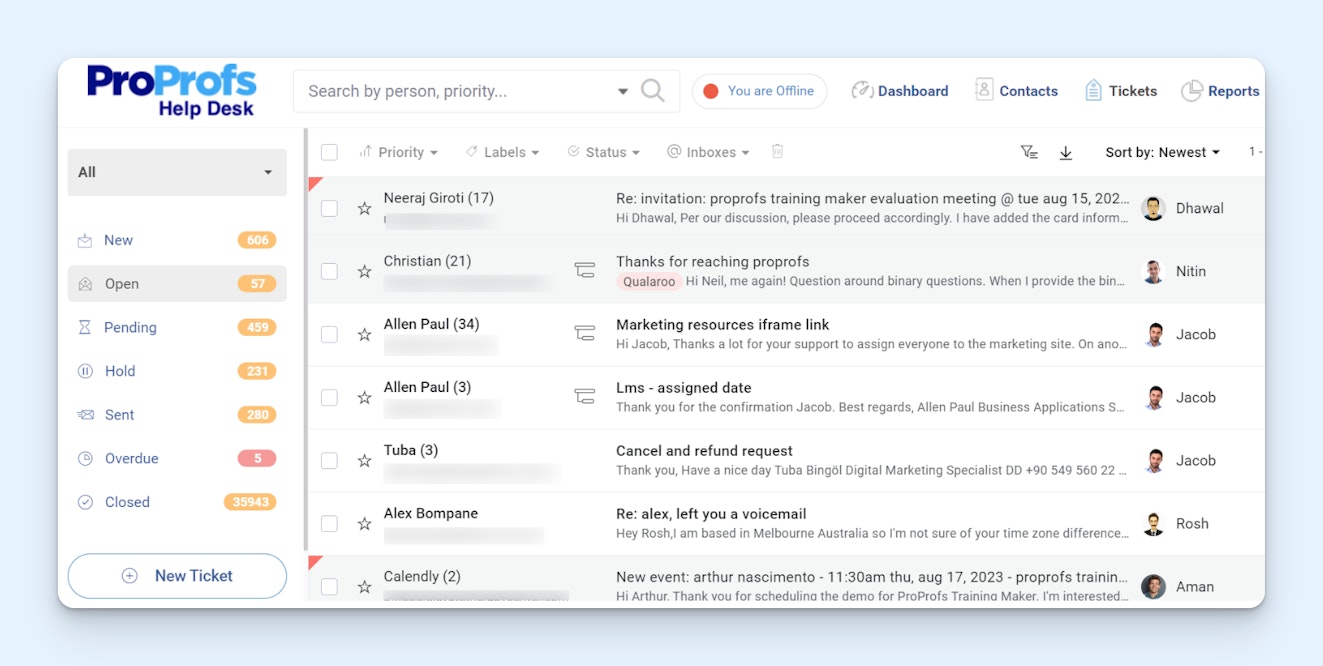
If you only have one person at your company doing all of your customer support, ProProfs Help Desk is a good option. The one-user limit is the only limit on the plan; you get unlimited access to all of its other features, including features you won’t find in other free plans like custom fields, a Salesforce integration, and multiple inboxes.
Free plan features
Email support: ProProfs Help Desk is limited to email support only. If you want to add a knowledge base or live chat, you’ll need to also subscribe to ProProfs Knowledge Base or ProProfs Live Chat (though those products also offer free plans). You can create an unlimited number of shared inboxes on ProProfs Help Desk’s free plan.
Unlimited feature usage and tickets: There are no limits on the features you can use, the number of times you can use those features, or the number of email requests you can reply to.
Productivity features: Set a maximum resolution time, then see when tickets are overdue. Create canned responses to reply to FAQs quickly. Add custom fields to your intake forms to get the information you need from customers upfront.
Customer feedback: Collect customer satisfaction ratings on closed requests.
Integrations: Connect ProProfs Help Desk with other ProProfs products like Live Chat, Knowledge Base, and Survey Maker. Integrate your help desk with Salesforce or Microsoft Dynamics.
What’s included?
ProProfs Help Desk’s free plan can be used by one person and includes unlimited inboxes, unlimited tickets and replies, customer feedback surveys, child tickets, canned responses, ticket labels, business hours, and the ability to customize your branding on the platform.
6. osTicket – Best open-source, self-hosted option
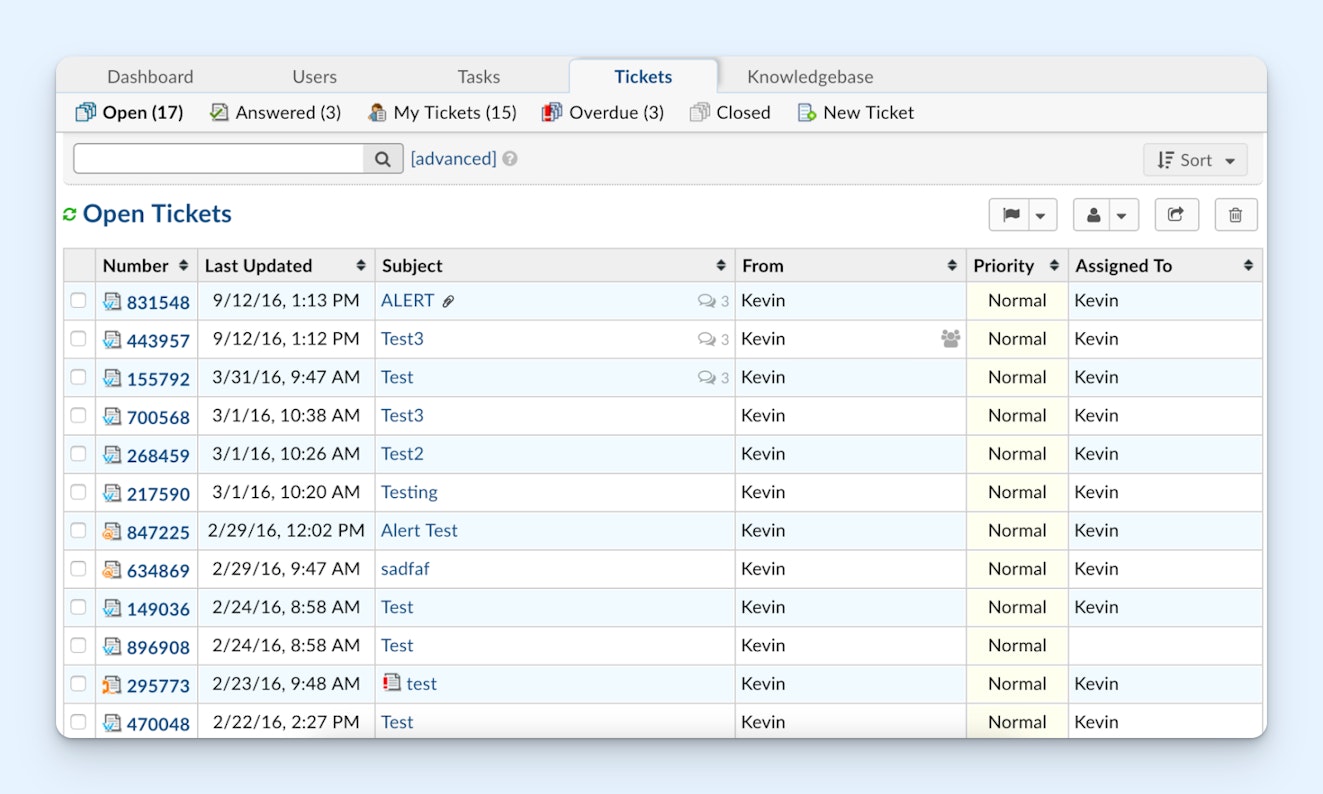
If you’re comfortable self-hosting your customer support platform, osTicket is a good choice. It’s an open source help desk that lets you deliver email support, and since you’re self-hosting it, there are no limits on the number of users you can add or tickets you can reply to. You can also use all of its features without limits and even build your own features if you need to.
Self-hosted plan features
Email support and customer portals: osTicket is limited to email support. There aren’t options for adding live chat, social, phone, or a help center. However, you can use it to create customer portals, which is a unique offering among the free tools on this list.
Organization features: Create custom columns and queues, add custom fields to intake forms, and automatically route tickets to the right individual/team.
Collaboration features: Prevent duplicate work with collision avoidance, assign tickets to another agent or transfer them to a different team, and create reference tickets that can be viewed but not edited by other individuals/teams.
Task management: Create to-do lists in the platform for specific agents or teams. To-dos can be tied to open tickets or created as standalone tasks.
What’s included?
The self-hosted, free version of osTicket includes email support for unlimited users and tickets and unlimited use of all of the platform’s features. However, you can only get access to community support on the free plan — no support is available from the osTicket team.
7. UVdesk – Best for ecommerce companies
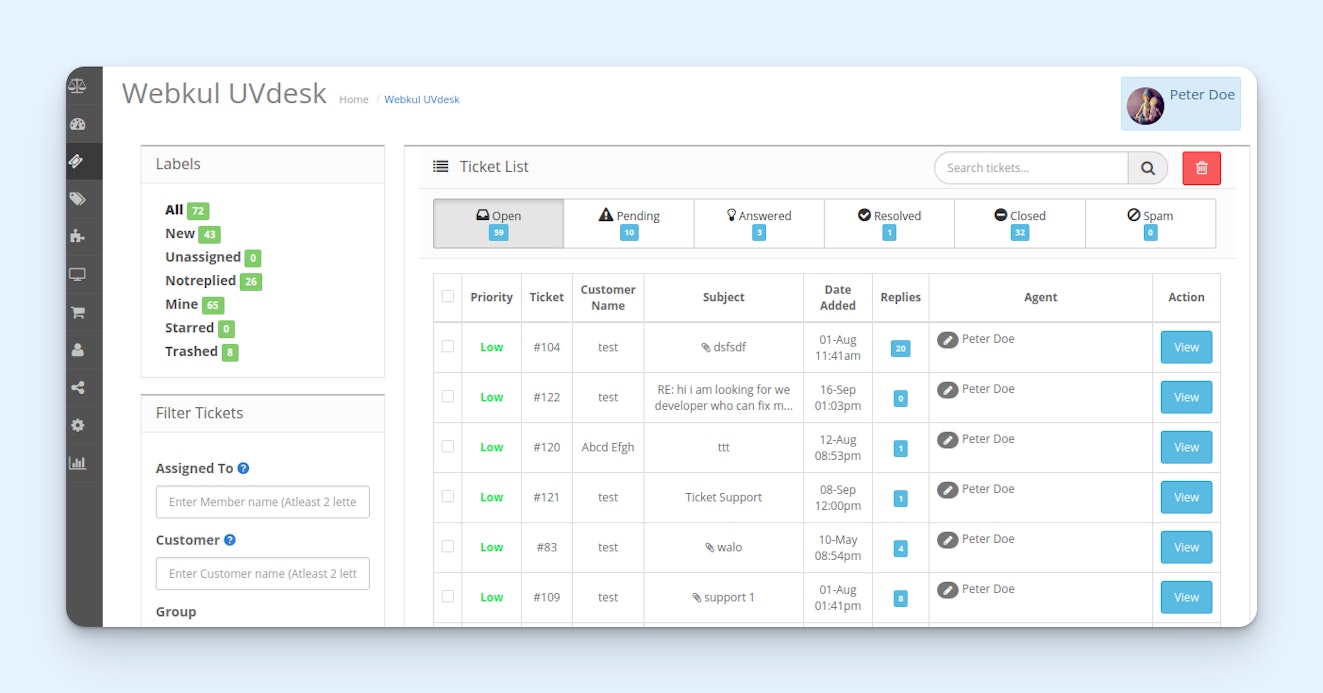
UVdesk is another open-source help desk that’s available for free if you self-host it. Like osTicket, it doesn’t have limits on the number of users you can add, tickets you can answer, or features you can use. What sets UVdesk apart is that it caters more to ecommerce companies with its pre-built integrations with Shopify, Magento 2, BigCommerce, and more.
Self-hosted plan features
Email support and knowledge base: Bring support requests from multiple email addresses into UVdesk’s help desk, and create a knowledge base to make it easy for customers to find answers to their questions on their own.
Ecommerce integrations: Take advantage of pre-built integrations with ecommerce platforms like Shopify, Magento 2, Opencart, PrestaShop, Amazon, and WooCommerce.
Unlimited users and tickets: Add as many users as you need to the platform, view reports on each agent’s performance, and receive and reply to as many requests as your customers send for free.
Productivity features: Create a library of saved replies to respond to FAQs quickly, and build workflows to automatically route tickets to the right place.
What’s included?
The self-hosted, free version of UVdesk includes email support for unlimited users and tickets, a knowledge base, ecommerce platform integrations, and unlimited use of all of the open-source platform’s features.
8. Tidio – Best for video chat support
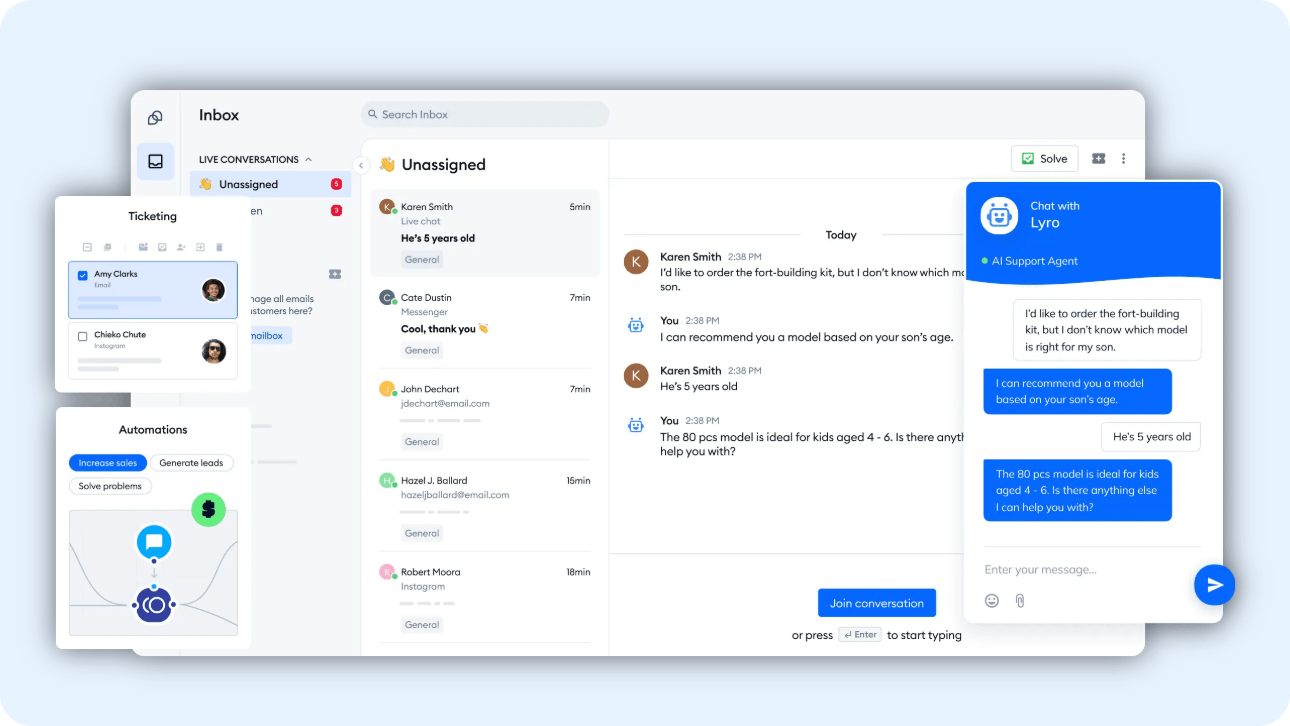
Tidio’s free plan is a good option if you want to deliver support via live video calls; video calls can be initiated by customers through Tidio’s live chat widget. However, it is a bit more limiting than some of the other tools on this list with restrictions on the number of conversations you can handle and the number of users you can add on the free plan.
Tidio’s free plan features
Email, live chat (text and video), and social support: Handle up to 50 conversations per month over email, live chat, Messenger, Instagram, or WhatsApp.
AI chatbot: Use Tidio’s chatbot, Lyro AI, to automatically reply to up to 50 conversations for free. Additional usage will require a paid upgrade.
Flows: Create automated workflows that prompt customers to engage with you via your live chat widget. Use them to share coupon codes, encourage visitors to schedule a meeting with your sales team, promote your mobile app, and more. Your first 100 views of Flows are included for free.
What’s included?
Tidio’s free plan can be used by up to 10 users to reply to up to 50 billable conversations. It comes with a help desk, live chat widget, basic analytics, and integrations with Messenger, Instagram, and WhatsApp.
Choosing the right Zendesk alternative for your business
Migrating to a new support platform requires a lot of work and entails a lot of risk. It's not an exercise you want to do more than once, so it's crucial to make the right decision about which platform to switch to the first time.
Here are some things to consider as you're evaluating options so you can make sure you find the perfect alternative for your team.
Does it have the essential features your team needs?
Before you start shopping, make a list of all of the features your team depends on in their day-to-day work, and determine which are must-haves. When you know exactly what you need, it's a lot easier to remove platforms that don't offer those features from your consideration list.
The best way to figure out if a platform has all of the features you need is to look at its pricing page. Most platforms provide more detail on this page in a side-by-side plan comparison table than any other page of their sites. Generally, this table will list every single feature available in the platform, so it's a good place to start when doing your research.
The bonus of identifying available features in this way is that you'll start to get a good understanding of the platform's pricing, too. Lots of tools look like they're a lot cheaper than they are at a glance, but by reviewing the plan comparison chart, you can start to understand which plan actually has all of the features you need and how much you're going to have to pay to get them.
Does it support all of the channels that you support?
Make sure it provides phone support if you support customers over the phone, customer portals if you want private spaces to share support statuses with specific customers, and social support for all of the social media sites you use to communicate with customers.
Can it be customized to fit some of your more unique needs?
Make sure the tool you choose integrates with any business-critical tools you use for delivering support and that it either comes with the reports you need out of the box or allows you to build custom reports that let you analyze your data and performance in the way you need to.
Will it scale alongside your team and business?
Since one of your goals should be to switch support platforms as infrequently as possible, it's important to consider not only how the platform will work for your team right now but also how it might work for you three years from now. Does it offer the features and channels you might need in the future?
What’s your timeline?
Some tools are easy to set up; others take more time to implement. Make sure you consider how long the initial setup and training will take. If you choose a tool that takes months to onboard, will you be able to afford to pay for both it and your existing support platform in the interim?
Can you afford it?
You likely have a budget to stick to when choosing your Zendesk replacement, making pricing another quick way to remove options from your consideration list. Just make sure you fully understand what you're getting at the price you believe you'll pay.
Once you've narrowed your list down to a handful of options you want to consider more deeply, schedule demos and/or start free trials of each. Demos let you get answers to the questions you couldn't find answers for on your own, and hands-on experience in a free trial will help you learn what works best in a real-world environment.
Finally, be sure to check out the quality of support each option delivers. Visit each tool’s help center, and send an email to their support team to evaluate how they handle customer interactions. Choosing a product with exceptional customer service can be a big differentiator, especially if all other things are equal.



